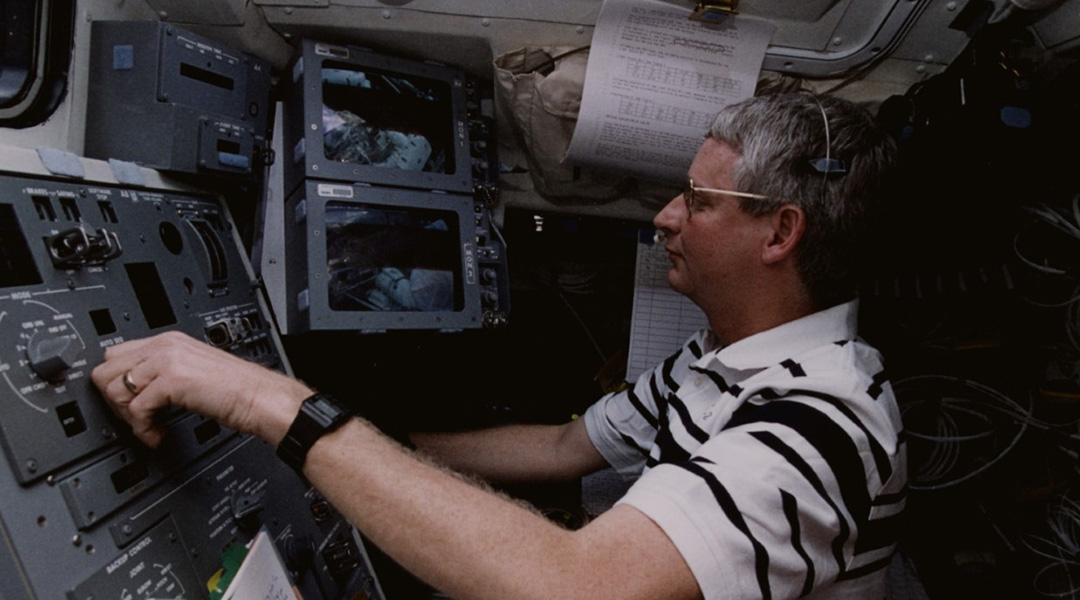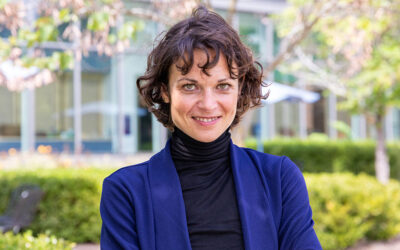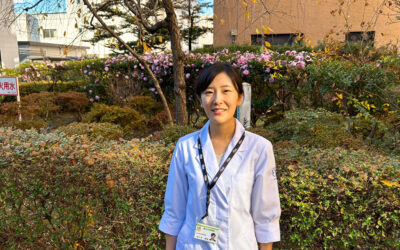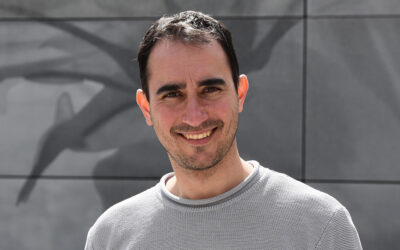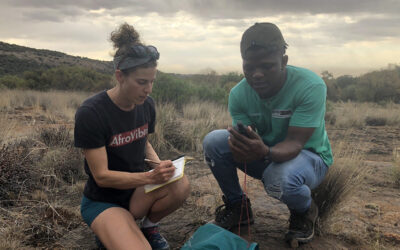Steven Hawley has lived the dreams of many. As an astronaut, he took part in five different NASA missions, amongst them the first flight of the Discovery Space Shuttle — one of NASA’s longest-serving orbiters, which carried satellites into space, helped in the International Space Stations (ISS) assembly missions, and brought the Hubble Space Telescope into orbit.
Hawley was pivotal in the launch and establishment of the Hubble Space Telescope and the Chandra X-ray Observatory, which are now joined by the recently launched James Webb Space Telescope.
On Earth, he has worked in academia for over 13 years, studying astronomy and astrophysics and specializing in observational spectroscopy, a technique used to measure the light originating from celestial objects, such as stars or galaxies. Hawley was particularly interested in the chemical evolution of active and star-forming galaxies as well as gaseous nebulae, which he assessed by investigating the presence of various chemical elements at different coordinates in space.
Outside of his work, Hawley is an enthusiastic hobby historian, documenting important milestones in the history of the Shuttle program to ensure that future generations of astronauts and engineers have the opportunity to learn from the expertise of previous missions.
We were thrilled to have the chance to speak with him to learn more about his impressive career, what it takes to be a full-fledged astronaut, and what mysteries he hopes astronomers will be able to uncover in our lifetime.
Did you always want to be an astronaut?
I was in grade school when Alan Shepard flew the first Mercury flight, and I was really interested in the space program and astronauts. I also knew that astronauts were test pilots, and knew I did not want to be a test pilot, I wanted to be an astrophysicist, so I did not realistically think there would ever be a chance for me.
It was not something I planned my career towards. However, even as a kid, I thought it would make sense for astronomy to put telescopes in space and they might want astronomers willing to go and operate them, but I never thought there would be a chance for me to do it as a full-time career.
What is NASA’s selection process like?
I was on the astronaut candidate selection board between 1984 and 2000. Back then there were some basic qualifications that everybody had to meet to just be eligible. They included a Bachelor’s degree in a technical discipline, three years of experience after college, have a height between 5’5″ and 6’4″ [165 cm and 193 cm] and be able to pass the flight physical. Those are not very constraining, however, so the people that were successful tended to have more of the qualitative requirements that NASA was looking for.
You applied as you would apply for any US government job. I knew about the opportunity when I was in graduate school — I was just finishing my Ph.D. and needed to find a job. Back in those days, the department office would receive letters from different places, mostly universities but some national laboratories, which had positions they wanted to fill in the coming year.
One day, I saw this letterhead that said “NASA” on it, and I thought that was very interesting. It said they were looking to hire astronauts to fly this new thing called the “Space Shuttle” and the thing that really caught my attention was that you did not have to be a test pilot. In that moment, I suddenly realized I could apply.
I dropped everything else I was working on — including my thesis — and I filled out the application. What surprised me was that it was a standard application you would fill out for any government job. I guess I thought it was going to say, “Application to be an Astronaut”.
In terms of the selection process, the applications would go to Johnson Space Center where the human resources people would screen out all the people that did not meet the basic eligibility requirements. Applicants were divided up into different categories depending on their specialty: the pilots, flight engineers, physical scientists, medical doctors, material scientists, basic engineers, etc., and then a panel would go through all those folders and try to rank the ones who might be most competitive.
We wanted people who had demonstrated the ability to learn, and that is often seen in someone who has gone beyond the Bachelor’s degree. I also wanted people who had good operational sense, good hand-eye coordination, who were good leaders when it was necessary or good followers when necessary, good communicators, and who would be good representatives for NASA.
We then bring some of these people to Houston and conduct interviews. This is where you really get to know them, and so we would generally bring maybe five to ten times as many people to Houston to interview as we intended to select. We call it an interview, but it is actually a week of evaluations and medical tests. It was also important to us that the applicants understood the job, and so part of the week was devoted to letting the candidates go around and talk to astronauts and ask them questions.
As we got later and later into the program, one dimension that became important was language skill because suddenly we are flying with the Russians, Japanese, and Germans, and the ability to learn a foreign language was important. Everyone that flies on the space station had to know English and Russian. If you had something in your background that showed you worked collaboratively with people from another country, then you might be comfortable with the multicultural nature of the of the job. I do not know if it mattered when I applied, but I was working in Chile when they brought me in for an interview, so I was learning Spanish and I was living in another country and maybe that helped.
No candidate has everything, so you just mentally go down the list and see if a candidate reminds you of somebody that has been successful in the program, and you do your best to pick the people you think meet as many of those qualifications as possible.
You were part of the 1990 STS-31 Discovery mission, which launched the Hubble Space Telescope. What was Hubble built to do?
In the 1970s, people were campaigning to build the Hubble Telescope, but the actual idea for a big telescope in space goes back to 1946. The reason people were willing to take it seriously in the 70s was because we thought we had done all we could do from the ground. It was hard to make bigger telescopes than the ones we had because the mirrors were too heavy.
Space has a couple of advantages. One, of course, is being above the atmosphere, which does two things that are bad for astronomy. First, the atmosphere is not transparent to all forms of light, and secondly, the atmosphere is turbulent and so it smears what you are trying to look at and that affects the precision of your image. That is why we often put telescopes on top of mountains.
We felt that in order to make progress, we needed to overcome those two problems, and that meant going to space.
The technology we launch is often quickly overcome by advances we make on the ground. Suddenly, we have something working in space but with antiquated technology. One of the key design features of Hubble is our ability to develop more sophisticated instruments and then take those instruments to orbit for installation. In that way we were able to keep it as a state-of-the-art telescope for its lifetime.
That was what happened between 1993 and 2009, when we were able to go several times and replace old instruments with new ones. It is a far better telescope today than it was in 1990 when we launched it.
With Hubble in orbit, and then with the development of large, ground-based telescopes using segmented mirror technology, the two working together have been responsible for some of the most interesting discoveries, including many that I had not anticipated.
What was your role during the mission?
Hubble was designed to take full advantage of the size of the payload bay of the shuttle, so it was built as a big cylinder that filled up the shuttle’s entire volume. To make it fit, the solar rays had to be rolled up and stashed along the side and the antennas had to be folded down, a bit like what James Webb went through except it had more things to deploy than Hubble.
For the [Hubble] mission, we needed to take it to the proper orbit and then use the robot arm on the shuttle to grab the telescope and lift it up, point it where it needed to be then have everything deploy automatically. My job was to operate the arm and lift the telescope out. My two crewmates, Bruce McCandless and Kathy Sullivan, were trained to go outside and do a spacewalk in the event that some of these automatic deployments did not happen properly. Ideally, in the best case, they would not have anything to do.
As it turned out, things were not ideal that day. The solar array is like a shade kit and there is a boom which folds out and then the solar array is extended like a curtain. The first one worked fine, but the second one did not. The boom went out fine, but when the ground controllers sent the command, the array started to come out and then it stopped. That was one of the “what ifs” we had thought about, so Bruce and Kathy got in their spacesuits, got their tools together, and got in the airlock preparing to go outside to manually crank the solar rays out.
While they were doing that, ground control was troubleshooting what could be done and, after some time, they tried disabling a sensor that monitored tension in the solar arrays to prevent asymmetrical deployment, which could damage the array. The sensors were designed to shut the motor off if the tension went beyond some limit. What happened was the sensor was wrong and it said there was a problem when there actually was no problem. Ground control was able to disable that sensor and then everything worked fine.
Unfortunately for Bruce and Kathy, we had gone far enough that they were in the airlock, the hatch was closed, and they had depressurized down to five pounds per square inch [34.5 kPa], which is a place where you would normally hold and wait for a final clearance to exit the airlock. By the time they got there, it looked like the problem was going to be resolved, and so they did not go down to vacuum and out into space, but they also did not re-pressurize and leave the airlock because there were still some things that could happen where they would still need to go out and try to deal with it. We just kept them in the airlock for the rest of the deployment, and I have joked with Kathy for the last 30 years that she missed the whole deployment because she was stuck in the airlock.
Your last space flight in 1999 involved deploying the Chandra X-ray Observatory. Can you tell us was made the Chandra X-ray Observatory so special? How did it compare to Hubble?
In some ways, it was like Hubble in the sense that Hubble and Chandra were two of the four great observatories. There was a program developed in the 1970s where NASA convinced congress to fund four major observatories in space, each of which would be designed to observe specifically in one region of the [electromagnetic] spectrum. Hubble looked primarily in visible light, Chandra looked in the X-ray, the Spitzer Space Telescope observed in the infrared, and the Compton Gamma Ray Observatory observed in the gamma ray spectrum.
You can do some of what Hubble does from the ground, you just cannot necessarily do it as well. X-rays don’t get to the ground, and so the only way to observe X-rays was with some orbiting satellites. What Chandra did for X-ray astronomers was like comparing the little telescope I used to have when I was a kid in my backyard to the 200 inch [508 cm] Palomar Telescope. That was the advance Chandra was able to make over what had previously been available — it was going to open up the X-ray universe in a way that was not possible before.
Chandra was originally designed to be put in low Earth orbit — like Hubble — but in 1992, the Chandra team got a budget cut and they decided that the best way to handle it was to not make it serviceable. If it is not serviceable, then you do not have to budget for new instruments and you do not have to budget for shuttle flights to go there. Now there was no reason to be in low Earth orbit, and so when we launched it, we put Chandra in an orbit that took it a third of the way to the Moon. It is in a big elliptical orbit, which gives it a little more observing time than it would have in low Earth orbit.
Chandra uses reaction wheels that do the pointing, but when they need to do maintenance on them, it uses propulsion, so Chandra has fuel. That was the limiting commodity for the lifetime of the observatory when we launched it. I believe the initial lifetime was five years based on propellant, and then it was extended and extended and it is still going fine to this day.
You have over 770 hours on five different space missions covering a 15-year span. What was your favorite moment or event?
My favorite event was when we deployed Hubble in 1990 knowing that this was the result of an idea from 1946 and so many people had worked for so many years to make it happen. It was hopefully going to rewrite astronomy textbooks.
My most memorable moment was the first time I saw the Earth from space after my first launch. When the engines cut off, Discovery was pointed in a direction where I could not see anything other than the black of space. Then we maneuvered and the Earth sort of slowly appeared in the forward windows.
All of my missions were low inclination orbits where you fly mostly over the water, so I saw a lot of ocean and not a lot of land, but one of the things that stuck with me was that the Earth is really cloudy most of the time. Also, after a while I noticed that the geography of different parts of the world had unique characteristics. Australia has a very distinct sort of reddish color, the Chilean Andes are sort of chocolate brown, the Brazilian rainforest has a distinctive look, and Africa is very noticeable with the deserts and the Nile River. I was eventually able to tell where I was over the world just by recognizing the color or the features of the terrain.
NASA recently launched the James Webb Space Telescope. What new insights will it provide?
The James Webb Space Telescope is optimized to look in the infrared part of the spectrum. It will look at some of the youngest objects in the universe.
Light from very distant objects is affected dramatically by the expansion of the universe, and so the light from the first stars and galaxies are going to be primarily visible in the infrared. That is what Webb is supposed to find.
Even with Hubble, we have been able to identify some very distant galaxies, and then we use the big 10 m class telescopes on the ground to try to see these objects in enough detail to determine some of their properties and to confirm their ages. What we are seeing is galaxies that formed well within the first 1 billion years of the age of the universe, and frankly, it’s hard for us to understand how that could happen. How is it that galaxies could come together so quickly? That is one of the interesting problems that hopefully the James Webb Space Telescope will help us solve.
We also want to know where the first stars came from because they are going to be unique. The stars we see today are primarily hydrogen and helium, but they have other elements in them because elements are made by stars generation after generation. The first-generation stars are only going to have hydrogen and helium. People have done computer models and the models suggest that the first stars could be kind of weird.
We are now discovering more and more planets around stars outside the solar system, in particular with a satellite called the Transiting Exoplanet Survey Satellite or TESS, which is the successor to the Kepler satellite. TESS is designed specifically to look at nearby stars and search for planets. In particular, if we can find one that has an atmosphere, we might be able to study the atmosphere with the James Webb Space Telescope, and if we can do that, we might find evidence in the atmosphere that the conditions are favorable for life.
What mysteries of the universe are astronomers hoping to solve in our lifetime?
One of the most significant mysteries to solve would be what is dark energy.
When we launched Hubble in 1990, we did not know the value of the Hubble constant, which is the measure of how fast the universe is expanding and basically tells you its age. It turned out to be about 13.7 billion years old based on Hubble observations and over the decades that followed, astronomers worked to try to refine that number. In doing so, they discovered something that is truly remarkable; everyone knew the universe is expanding, but everyone assumed it was slowing down. However, astronomers discovered that the universe’s expansion is actually speeding up, and that did not make any sense. The first time I heard that in 1998, I said that is the dumbest thing I had ever heard, but it turned out to be true. We do not know what is causing it, but we call it dark energy.
The second mystery I would hope to be solved is to determine why there is more matter in the universe than we can account for visually. In the end, astronomers have decided that there is a component to the universe called dark matter, which acts gravitationally but in no other way. It does not produce light, so you cannot see it.
Dark matter and dark energy together are responsible for about 95% of what makes up the universe. Everything that I studied in school, everything I did as an astronomer, turns out dealt with 5% of everything; we are pretty much clueless about 95% of the universe. There are some proposals about how you might be able to detect dark matter more directly. Right now, we infer its presence because of the gravitational effect we ascribe to it, but nobody has detected a dark matter particle, and I do not think we have any idea about dark energy.
Would you fly to space again as a tourist if you could?
Well, I would not pay for it and I do not think I would find it very satisfying. The times I went, I had a reason to be there, and I had some amount of control over what was going on. I do not think I would want to go just as a passenger with no control. Now, if Jeff Bezos called me tomorrow and asked if I would like to come fly and compare my experience with what I had on the shuttle, I would probably think about it, but my instinct would be to say I am not interested.
You were also a professor of physics and astronomy as well as the director of engineering physics at the University of Kansas. Can you tell us briefly about the research you conducted during your tenure?
I was an observer, so I used telescopes, and I was a spectroscopist, so I took spectra of ionized gas. In the spectrum of ionized gas, typically what you see are discrete emission lines and the emission lines are associated with specific atoms. What I wanted to do was to look at what elements were present in different places in a galaxy and in different galaxies. Galaxies evolve chemically over time, and that was what I was interested in studying. How does the chemical evolution of galaxies take place and do we have a story that holds together for how all the different processes work to produce the chemical enrichment.
My thesis was about looking at abundances of oxygen and nitrogen in the Milky Way. I was able to show that near the center of the Milky Way, the abundances are higher and out near the edge, they are lower. That kind of makes some sense because near the center of the galaxy, the star density is higher. You are going to have more supernovae and more stars exploding, which give off these heavy elements back to the interstellar medium where you can make new stars.
I looked at the common elements like helium, oxygen, nitrogen, neon, carbon, and sulfur. We thought that heavy elements were made in supernovae and, for the most part, that is true, but what we found in the last five or ten years, things like gold are made when neutron stars collide. That sort of blew my mind because people had theorized that, but frankly, I never thought neutron stars would actually collide, but they do and they have now been detected.
In the old days, I used to work with my thesis advisor on what were known as “active galaxies” before we knew for sure there were black holes. We speculated that what we were looking at had to be black holes, but nobody had proved that yet. That was right before I think people began to accept that black holes really existed and were responsible for some of the most energetic objects in the universe.
Your late brother, John F. Hawley, was also an astrophysicist. How often did you both discuss research ideas?
I was always really interested in what he was doing, but truthfully what we did were really far apart. I was an observational spectroscopist and he was a theoretical astrophysicist who did supercomputing. He would tell me what he was doing, and I understood some of it, but frankly, a lot of the details were difficult for me to grasp. He was interested in what I was doing when I was working on active galaxies and black holes because he also worked on aspects of black holes. He was seven years younger than I, so there was a time when he was getting old enough in school that he was developing this interest in astronomy, but by then, I was off at graduate school and we were not constantly talking about astronomy things.
He won the Shaw prize, which he shared with his collaborator, so he split $1,000,000 for his work on accretion disks around black holes. I told him there was a time early in my career when people would ask John if he was Steve Hawley’s brother. For about the last half of my career, people were asking me if I was John Hawley’s brother because he was the one that was getting a lot of attention for the research he was doing. He did tell me that I was more influential on him and his interest in astronomy than I had ever realized. I did not realize how young he was when he decided he wanted to do astronomy, so that was kind of nice to hear.
What is …
The most important thing you brought to space with you?
Glasses. Hubble is covered with silver foil that is an insulation and when the sun shines on it, it is incredibly bright. I was supposed to be operating the arm and looking out the window at the telescope and was blinded by the glare. Fortunately, I had sunglasses, so I was able to wear my sunglasses and that helped.
Your favorite travel destination on Earth?
Every time we go out on a trip with our dogs in our RV, what I really like is when we get back home, so maybe my favorite travel destination is home after we have been out for a couple of weeks camping.
Your favorite hobby?
Trying to document what I think are important things that happened in the history of the shuttle program. I do think there is going to be a tendency for the shuttle to be overlooked. I was writing a technical article several years ago on some work we did for the second Hubble servicing mission, and some of the details I was having trouble remembering. I got in touch with some guys in Houston to ask them and they did not have any of those documents because they did not keep them. When the shuttle program ended, most of the effort was not in capturing the history of the program, the lessons learned, what was done, why was it done and how it worked. That seemed a shame to me.
As programs end, nobody really puts a priority on doing a knowledge capture because there is just a lot of it, and it would be a lot of work to do. What I have been working on for the last couple of years is how much of what I know can I record so that someday, if people care, there is a little history of what we actually did and how it worked and why did what we had to do it that way. It has been fun for me, so that is why I think of it maybe as a hobby, because I do have a lot of information that I have to sit down and work through.
A good read you can recommend?
I have always liked Asimov and the Foundation series. I like Andy Weir and I read The Martian and enjoyed it. I also like reading books that popularize science. Professor Brian Greene at Columbia is a physicist who writes very engagingly about very complicated problems in physics.
A discovery (any research field or time) you wish you would have made?
I always enjoyed the progress we made as a discipline, so I do not remember ever wishing I had discovered something that somebody else did. I was just glad somebody had discovered it.
The closest thing I would say is dark energy.
A person (famous or not) you would like to have lunch with?
If I could, I would have lunch with John [my brother] because I miss him.
Who would play you in a biopic?
I was thinking Matt Damon perhaps because he was in The Martian. My wife thinks Gary Sinise, but I am not sure about that. I was also thinking Ryan Reynolds. When I was young, the guy that would look the most like me back then was Ed Sheeran because I had curly red hair.

